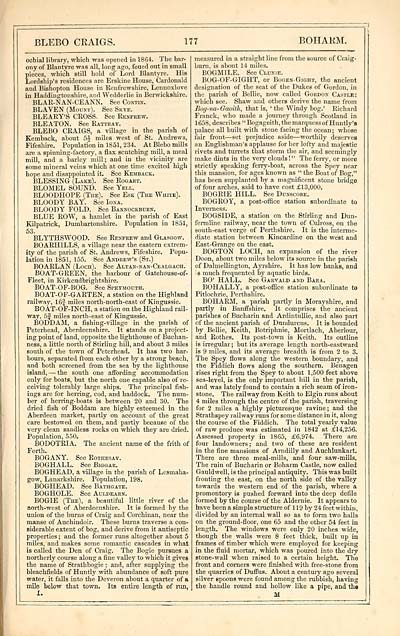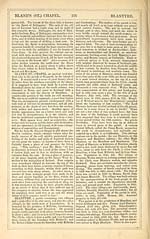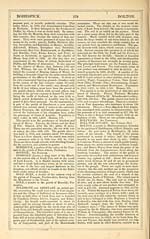Download files
Complete book:
Individual page:
Thumbnail gallery: Grid view | List view

BLEBO CRAIGS.
177
BOH A KM.
ochial library, which was opened in 18G4. The bar-
ony of Blantyre was all, long ago, feued out in small
pieces, which still hold of Lord Blantyre. His
Lordship's residences arc Erskine House, Cardonald
and Bishopton House in Renfrewshire, Lennoxlove
in Haddingtonshire, and Wedderlie in Berwickshire.
BLAR-NAN-CEANN. See Contin.
BLAVEN (Mount). See Skte.
BLEARY'S CROSS. See Renfrew.
BLEATON. See Rattray.
BLEBO CRAIGS, a village in the parish of
Kemback, about 5A miles west of St. Andrews,
Fifeshire. Population in 1851, 234. At Blebo mills
are a spinning-factory, a flax scutching mill, a meal
mill, and a barley mill; and in the vicinity are
some mineral veins which at one time excited high
hope and disappointed it. See Kemback.
BLESSING (Lake). See Rogart.
BLOMEL SOUND. See Yell.
BLOODHOPE (The). See Esk (The White).
BLOODY BAY. See Iona.
BLOODY FOLD. See Bannockbdrn.
BLUE ROW, a hamlet in the parish of East
Kilpatrick, Dumbartonshire. Population in 1851,
53.
BLYTHSWOOD. See Renfrew and Glasgow.
BOARHILLS, a village near the eastern extrem-
ity of the parish of St. Andrews, Fifeshire. Popu-
lation in 1851, 155. See Andrew's (St.)
BOARLAN (Loch). See Altan-nan-Cealgach.
BOAT-GREEN, the harbour of Gatehouse-of-
Fleet, in Kirkcudbrightshire.
BOAT-OF-BOG. See Spbtmodth.
BOAT-OF-GARTEN, a station on the Highland
railwav, 16J miles north-north-east of Kingussie.
BOAT-OF-INCH, a station on the Highland rail-
way, 5J miles north-east of Kingussie.
BODDAM, a fishing-village in the parish of
Peterhead, Aberdeenshire. It stands on a project-
ing point of land, opposite the lighthouse of Buchan-
ness, a little north of Stirling hill, and about 3 miles
south of the town of Peterhead. It has two har-
bours, separated from each other by a strong beach,
and both screened from the sea by the lighthouse
island, — the south one affording accommodation
only for boats, but the north one capable also of re-
ceiving tolerably large ships. The principal fish-
ings are for herring, cod, and haddock. The num-
ber of herring-boats is between 20 and 30. The
dried fish of Boddam are highly esteemed in the
Aberdeen market, partly on account of the great
care bestowed on them, and partly because of the
very clean saudless rocks on which they are dried.
Population, 550.
BODOTRIA. The ancient name of the frith of
Forth.
BOGANY. See Rothesay.
BOGHALL. See Biggar.
BOGHEAD, a village in the parish of Lesmaha-
gow, Lanarkshire. Population, 198,
BOGHEAD. See Bathgate.
BOGHOLE. See Auldearn.
BOGIE (The), a beautiful little river of the
north-west of Aberdeenshire. It is formed by the
union of the burns of Craig and Corchinan, near the
manse of Auchindoir. These burns traverse a con-
siderable extent of bog, and derive from it antiseptic
properties ; and the former runs altogether about 5
miles, and makes some romantic cascades in what
is called the Den of Craig. The Bogie pursues a
northerly course along a fine valley to which it gives
the name of Strathbogie ; and, after supplying the
bleachfields of Huntly with abundance of soft pure
water, it falls into the Deveron about a quarter of a
mile below that town. Its entire length of run,
I.
measured in a straight line from the source of Craig-
burn, is about 1-1 miles.
BOGM1LE. See Clunie.
BOG-OF-GIGHT, or Bogen-Gioht, the ancient
designation of the seat of the Dukes of Gordon, in
the parish of Bellie, now called Gordon Castle:
which see. Shaw and others derive the name from
Bog-na-Oaoith, that is, ' the Windy bog.' Richard
Franck, who made a journey through Scotland in
1658, describes "Bogageith, the marquess of Huntly'a
palace all built with stone facing the ocean; whose
fair front — set prejudice aside — worthily deserves
an Englishman's applause for her lofty and majestic
rivets and turrets that storm the air, and seemingly
make dints in the very clouds ! " The ferry, or more
strictly speaking ferry-boat, across the Spey near
this mansion, for ages known as " the Boat of Bog,"
has been supplanted by a magnificent stone bridge
of four arches, said to have cost £13,000.
BOGRIE HILL. See Dunscore.
BOGROY, a post-office station subordinate to
Inverness.
BOGSIDE, a station on the Stirling and Dun-
fermline railway, near the town of Culross, on the
south-east verge of Perthshire. It is the interme-
diate station between Kincardine on the west and
East-Grange on the east.
BOGTON LOCH, an expansion of the river
Doon, about two miles below its source in the parish
of Dalmellington, Ayrshire. It has low banks, and
is much frequented by aquatic birds.
BO' HALL, See Garvald and Bara.
BOHALLY, a post-office station subordinate to
Pitlochrie, Perthshire.
BOHARM, a pariah partly in Morayshire, and
partly in Banffshire, It comprises the ancient
parishes of Bucharin and Ardintullie, and also part
of the ancient parish of Dundurcus. It is bounded
by Bellie, Keith, Botriphnie, Mortlach, Aberlour,
and Rothes. Its post-town is Keith. Its outline
is irregular; but its average length north-eastward
is 9 miles, and its average breadth is from 2 to 3.
The Spey flows along the western boundary, and
the Fiddich flows along the southern. Benagen
rises right from the Spey to about 1,500 feet above
sea-level, is the only important hill in the parish,
and was lately found to contain a rich seam of iron-
stone. The railway from Keith to Elgin runs about
4 miles through the centre of the parish, traversing
for 2 miles a highly picturesque ravine ; and the
Strathspey railway runs for some distance in it, along
the course of the Fiddich. The total yearly value
of raw produce was estimated in 1842 at £14,256.
Assessed property in 1865, £6,974. There are
four landowners; and two of these are resident
in the fine mansions of Amdilly and Auchlunkart.
There are three meal-mills, and four saw-mills.
The ruin of Bucharin or Boharm Castle, now called
Gauldwell, is the principal antiquity. This was built
fronting the east, on the north side of the valley
towards the western end of the parish, where a
promontory is pushed forward into the deep defile
formed by the course of the Aldernie. It appears to
have been a simple structure of 1 1 9 by 24 feet within ,
divided by an internal wall so as to form two halls
on the ground-floor, one 65 and the other 54 feet in
length. The windows were only 20 inches wide,
though the walls were 8 feet thick, built up in
frames of timber which were employed for keeping
in the fluid mortar, which was poured into the dry
stone-wall when raised to a certain height. The
front and corners were finished with free-stone from
the quarries of Duffus. About a century ago several
silver spoons were found among the rubbish, having
the handle round and hollow like a pipe, and th»
M
177
BOH A KM.
ochial library, which was opened in 18G4. The bar-
ony of Blantyre was all, long ago, feued out in small
pieces, which still hold of Lord Blantyre. His
Lordship's residences arc Erskine House, Cardonald
and Bishopton House in Renfrewshire, Lennoxlove
in Haddingtonshire, and Wedderlie in Berwickshire.
BLAR-NAN-CEANN. See Contin.
BLAVEN (Mount). See Skte.
BLEARY'S CROSS. See Renfrew.
BLEATON. See Rattray.
BLEBO CRAIGS, a village in the parish of
Kemback, about 5A miles west of St. Andrews,
Fifeshire. Population in 1851, 234. At Blebo mills
are a spinning-factory, a flax scutching mill, a meal
mill, and a barley mill; and in the vicinity are
some mineral veins which at one time excited high
hope and disappointed it. See Kemback.
BLESSING (Lake). See Rogart.
BLOMEL SOUND. See Yell.
BLOODHOPE (The). See Esk (The White).
BLOODY BAY. See Iona.
BLOODY FOLD. See Bannockbdrn.
BLUE ROW, a hamlet in the parish of East
Kilpatrick, Dumbartonshire. Population in 1851,
53.
BLYTHSWOOD. See Renfrew and Glasgow.
BOARHILLS, a village near the eastern extrem-
ity of the parish of St. Andrews, Fifeshire. Popu-
lation in 1851, 155. See Andrew's (St.)
BOARLAN (Loch). See Altan-nan-Cealgach.
BOAT-GREEN, the harbour of Gatehouse-of-
Fleet, in Kirkcudbrightshire.
BOAT-OF-BOG. See Spbtmodth.
BOAT-OF-GARTEN, a station on the Highland
railwav, 16J miles north-north-east of Kingussie.
BOAT-OF-INCH, a station on the Highland rail-
way, 5J miles north-east of Kingussie.
BODDAM, a fishing-village in the parish of
Peterhead, Aberdeenshire. It stands on a project-
ing point of land, opposite the lighthouse of Buchan-
ness, a little north of Stirling hill, and about 3 miles
south of the town of Peterhead. It has two har-
bours, separated from each other by a strong beach,
and both screened from the sea by the lighthouse
island, — the south one affording accommodation
only for boats, but the north one capable also of re-
ceiving tolerably large ships. The principal fish-
ings are for herring, cod, and haddock. The num-
ber of herring-boats is between 20 and 30. The
dried fish of Boddam are highly esteemed in the
Aberdeen market, partly on account of the great
care bestowed on them, and partly because of the
very clean saudless rocks on which they are dried.
Population, 550.
BODOTRIA. The ancient name of the frith of
Forth.
BOGANY. See Rothesay.
BOGHALL. See Biggar.
BOGHEAD, a village in the parish of Lesmaha-
gow, Lanarkshire. Population, 198,
BOGHEAD. See Bathgate.
BOGHOLE. See Auldearn.
BOGIE (The), a beautiful little river of the
north-west of Aberdeenshire. It is formed by the
union of the burns of Craig and Corchinan, near the
manse of Auchindoir. These burns traverse a con-
siderable extent of bog, and derive from it antiseptic
properties ; and the former runs altogether about 5
miles, and makes some romantic cascades in what
is called the Den of Craig. The Bogie pursues a
northerly course along a fine valley to which it gives
the name of Strathbogie ; and, after supplying the
bleachfields of Huntly with abundance of soft pure
water, it falls into the Deveron about a quarter of a
mile below that town. Its entire length of run,
I.
measured in a straight line from the source of Craig-
burn, is about 1-1 miles.
BOGM1LE. See Clunie.
BOG-OF-GIGHT, or Bogen-Gioht, the ancient
designation of the seat of the Dukes of Gordon, in
the parish of Bellie, now called Gordon Castle:
which see. Shaw and others derive the name from
Bog-na-Oaoith, that is, ' the Windy bog.' Richard
Franck, who made a journey through Scotland in
1658, describes "Bogageith, the marquess of Huntly'a
palace all built with stone facing the ocean; whose
fair front — set prejudice aside — worthily deserves
an Englishman's applause for her lofty and majestic
rivets and turrets that storm the air, and seemingly
make dints in the very clouds ! " The ferry, or more
strictly speaking ferry-boat, across the Spey near
this mansion, for ages known as " the Boat of Bog,"
has been supplanted by a magnificent stone bridge
of four arches, said to have cost £13,000.
BOGRIE HILL. See Dunscore.
BOGROY, a post-office station subordinate to
Inverness.
BOGSIDE, a station on the Stirling and Dun-
fermline railway, near the town of Culross, on the
south-east verge of Perthshire. It is the interme-
diate station between Kincardine on the west and
East-Grange on the east.
BOGTON LOCH, an expansion of the river
Doon, about two miles below its source in the parish
of Dalmellington, Ayrshire. It has low banks, and
is much frequented by aquatic birds.
BO' HALL, See Garvald and Bara.
BOHALLY, a post-office station subordinate to
Pitlochrie, Perthshire.
BOHARM, a pariah partly in Morayshire, and
partly in Banffshire, It comprises the ancient
parishes of Bucharin and Ardintullie, and also part
of the ancient parish of Dundurcus. It is bounded
by Bellie, Keith, Botriphnie, Mortlach, Aberlour,
and Rothes. Its post-town is Keith. Its outline
is irregular; but its average length north-eastward
is 9 miles, and its average breadth is from 2 to 3.
The Spey flows along the western boundary, and
the Fiddich flows along the southern. Benagen
rises right from the Spey to about 1,500 feet above
sea-level, is the only important hill in the parish,
and was lately found to contain a rich seam of iron-
stone. The railway from Keith to Elgin runs about
4 miles through the centre of the parish, traversing
for 2 miles a highly picturesque ravine ; and the
Strathspey railway runs for some distance in it, along
the course of the Fiddich. The total yearly value
of raw produce was estimated in 1842 at £14,256.
Assessed property in 1865, £6,974. There are
four landowners; and two of these are resident
in the fine mansions of Amdilly and Auchlunkart.
There are three meal-mills, and four saw-mills.
The ruin of Bucharin or Boharm Castle, now called
Gauldwell, is the principal antiquity. This was built
fronting the east, on the north side of the valley
towards the western end of the parish, where a
promontory is pushed forward into the deep defile
formed by the course of the Aldernie. It appears to
have been a simple structure of 1 1 9 by 24 feet within ,
divided by an internal wall so as to form two halls
on the ground-floor, one 65 and the other 54 feet in
length. The windows were only 20 inches wide,
though the walls were 8 feet thick, built up in
frames of timber which were employed for keeping
in the fluid mortar, which was poured into the dry
stone-wall when raised to a certain height. The
front and corners were finished with free-stone from
the quarries of Duffus. About a century ago several
silver spoons were found among the rubbish, having
the handle round and hollow like a pipe, and th»
M
Set display mode to: Large image | Transcription
Images and transcriptions on this page, including medium image downloads, may be used under the Creative Commons Attribution 4.0 International Licence unless otherwise stated. ![]()
| Gazetteers of Scotland, 1803-1901 > Imperial gazeteer of Scotland, or, Dictionary of Scottish topography > Volume 1 > (277) Page 177 |
|---|
| Permanent URL | https://digital.nls.uk/97462454 |
|---|
| Description | Volume I: Aan-Gordon. |
|---|---|
| Attribution and copyright: |
|

